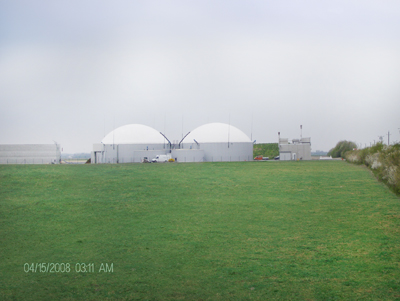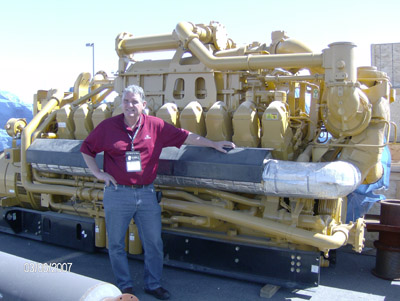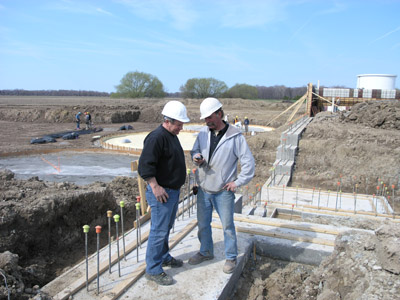
Leamington grower finds reliable heat source, with new revenue streams and greener products to boot.
Finding, and keeping, your energy edge in today’s greenhouse sector is a constant challenge. It involves more than clever procurement and managing for energy efficiency. It can also include trimming your carbon footprint, creating new revenue streams, and creating a marketing advantage for your products at the same time.
A recent project at Seacliff Energy in Leamington, ON does much of this, and more. Last January, the local power supplier produced its first kilowatt of power using an innovative two-stage digester paired to a Caterpillar low-emission genset. The digester is the first of its kind in North America, and is being fed by local waste products for a very low-carbon operation.
The operation is run by Dennis Dick and his cousin Roger Tiessen, and the partnership is the end result of a long search for an economically sound yet environmentally-friendly way to provide heat and power to Dick’s nearby greenhouse business.
 |
| The two-stage anaerobic digesters turn negative value food waste into biogas. Seacliff Energy Ltd. is a partnership between Gemini-Seacliff Power Corporation, Seacliff Energy Inc. and Alpenglow Energy, which will produce 1.6MW of green energy for the province of Ontario. |
 |
| Roger Tiessen is president of Seacliff Energy, and is shown here with the Caterpillar G3520 C1.6MW genset. |
 |
| Dennis Dick (at left) of Seacliff Energy with project site supervisor Keith Shantz at the construction site. The project was five years in the making from conception to power on the grid. |
Outside the box
There are many alternative energy options on today’s market, and the partners considered them all, from biomass and tires to digesters. They even looked overseas, but with limited success.
“We travelled quite extensively in Europe and did quite a bit of homework,” Dick said. “We continued to travel, had a great time, but we weren’t getting anywhere.”
So with some help from Agriculture and Agri-Food Canada, Seacliff hired a consultant to look for a solution to their specific set of challenges and opportunities. The consultant suggested looking at the two-stage anaerobic digesters being used successfully in Europe, a technology that mimics a cow’s stomachs in breaking down a wide array of organic matter using a variety of bacteria and temperatures.
“Once we realized that no burning process quite fit our needs at the greenhouse, we felt it was worthwhile to look at the two-stage digesters and off we went to Europe. After the first visit we were sold on the technology and knew that was the way we needed to go.”
Industry First
Seacliff Energy’s two-stage digestion technology is a first of its kind in North America. Developed by Gerhard Agrinz GmbH of Austria, it transforms organic materials into biogas. This in turn fuels a Cat G3520 C1.6MW high-efficiency, low-emission genset supplied by Toromont Cat Power Systems. Dick notes that his company has a 20-year contract with Ontario Power Authority to supply much-needed electricity from the system, enough to power 1,200 homes.
The CHP system also supplies heat to warm the adjacent cucumber and tomato greenhouse, Pelee Hydroponics, owned by Dick and his wife Vicki.
The digester is fed by agricultural waste, mostly from local food processors in this agricultural area. The supply includes corn, onions, celery, beans, cucumbers and cucumber prunings, corn silage as well as some swine and dairy cattle manure. The facility is expected to process more than 40,000 tonnes of waste organic material per year, some of which would end up in landfill. The project will also remove the equivalent of 5,217 tons of C02 per year.
And to complete the circle, what’s leftover from the process makes a good fertilizer. Dick notes that nutrients are not lost in the process, so that what comes out of the digester is almost equal to what goes in.
“We are able to separate the solids from the liquids and both can be used as fertilizer,” Dick says. “All the way around there are environmental benefits, and we have the added bonus of creating a profit centre for us.”
Reliable Technology
Dick adds that while two-stage digesting is a mature technology in Europe, with over 5,000 units running, it is new in North America. The implementation of any new technology is bound to bring challenges, such as finding parts and service. For that reason, when they looked at generators to use the biogas, the partners turned to Caterpillar and Toromont.
“We did a lot of research, we asked a lot of questions, and when it came to choosing the generator – that was an easy decision. Caterpillar has a reputation for generator quality and reliability, parts and service, and once we met the people at Toromont, it was a very easy decision to make.”
Dick says they like the Cat genset because it runs at a lower RPM than similar models, making it more efficient. Another plus to Dick is the way it handles hydrogen sulfide (H2S).
Biogas is a wet, warm byproduct with high H2S, a corrosive compound. Seacliff’s system takes the gas through a pipe underground where it is cooled by the ambient ground temperature. Moisture in the gas condenses, which removes a high percentage of the H2S. Mechanical filters remove more before the gas is ready for combustion.
“Not that we want to put high H2S levels in, but we can use more elevated H2S in the Caterpillar generator than in other brands,” Dick explains.
In an additional step to protect their considerable investment, Seacliff has engaged Toromont Cat Power Systems in a long-term service agreement. In fact, two Toromont associates, Joe Van Schaick and Reda Rafla, travelled to Europe with Dick and Tiessen to study the digesters. Dick says the trip was invaluable to understanding how the digester would work in tandem with the genset.
“There have been so many people who have helped us at Toromont and Caterpillar. They’ve gone above and beyond the call of duty,” Dick said. “Both Roger and I have been involved in farming, and Roger has run a number of other businesses. We know that service is such an important part of any equipment purchase. We know that Caterpillar and Toromont have all those pieces in place, that parts would be available, quickly.”
The system officially went on the grid January 27, 2011, thus producing not only heat for the greenhouses but revenue from two additional sources – electricity and fertilizer.
Not all Roses
Dick says the partners have experienced “a lot of roadblocks,” especially since this technology is so new to the province. “But at the same time,” adds Dick, “there have been a lot of people who were there to help.”
All levels of government – the local municipality, the province and the federal government – have been supportive of the project. Ontario’s Renewable Energy Standard Offer Program (RESOP), now known as the FIT (Feed-In Tariff) program, has been a major boost to the project. The Ontario Power Authority introduced RESOP in November of 2006 to encourage the development of renewable energy generation. The program was intended to remove obstacles for smaller renewable projects through a simplified procurement process while providing a fair and stable price for a 20-year term.
For its part, the federal government last year contributed a repayable contribution of up to $1.6 million to help with the project. “This is a new technology to Ontario,” Dick explains. “We’ve had to prove the economics, and show that it would be as successful here as it has been in Europe.”
And it has been successful. The “waste” heat will be used in the greenhouse. The processed material can be reused as a fertilizer. The waste fuel source no longer needs to be landfilled.
“There are so many upsides to this,” says Dick, along with some potential applications “we haven’t even considered yet.”
This article was originally published in RUNREADY, a publication from Caterpillar dealers for facility managers, with additional reporting and updating by Greenhouse Canada staff. It is re-printed here with permission.
Print this page